Healthcare Quality Assessment: Emergency Department Quality Indicators
VerifiedAdded on 2023/05/27
|12
|2928
|441
Report
AI Summary
This report assesses quality within a healthcare emergency department using Donabedian's Triad (structure, process, and outcomes). It defines and rationalizes the selection of ten quality indicators, including human resources, non-human resources, availability of health information systems, waiting time, medication administration, staff-patient communication, hospital reputation & patient satisfaction, length of stay (LOS) & Left against Medical Advise (LAMA) & return to the ER after discharge (readmission), and patient education. The report details data collection plans, including frequency, sources, and methods, and specifies the target or goal for each indicator. The ultimate aim is to enhance the delivery of quality care by providing insights into these crucial elements.
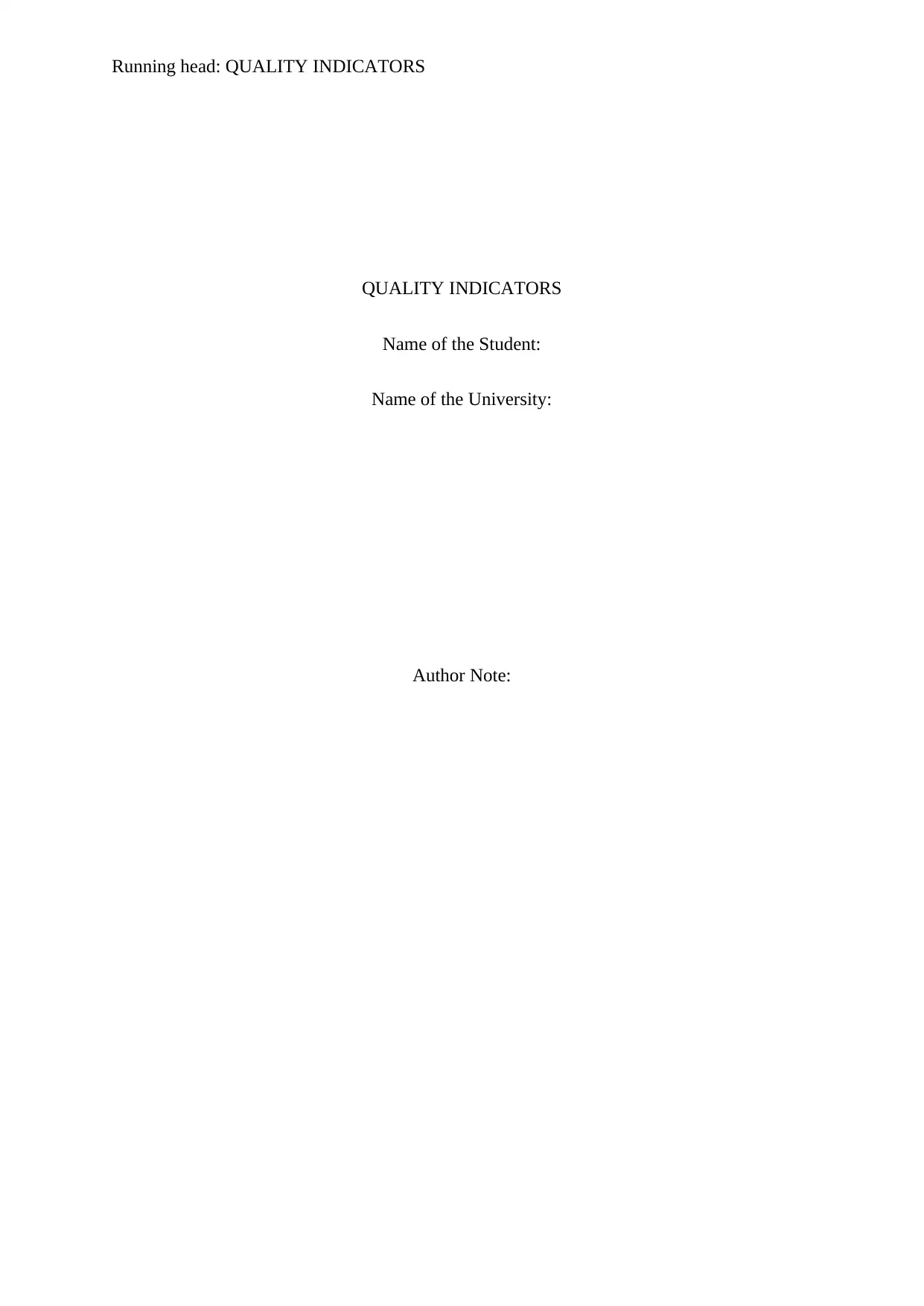
Running head: QUALITY INDICATORS
QUALITY INDICATORS
Name of the Student:
Name of the University:
Author Note:
QUALITY INDICATORS
Name of the Student:
Name of the University:
Author Note:
Paraphrase This Document
Need a fresh take? Get an instant paraphrase of this document with our AI Paraphraser
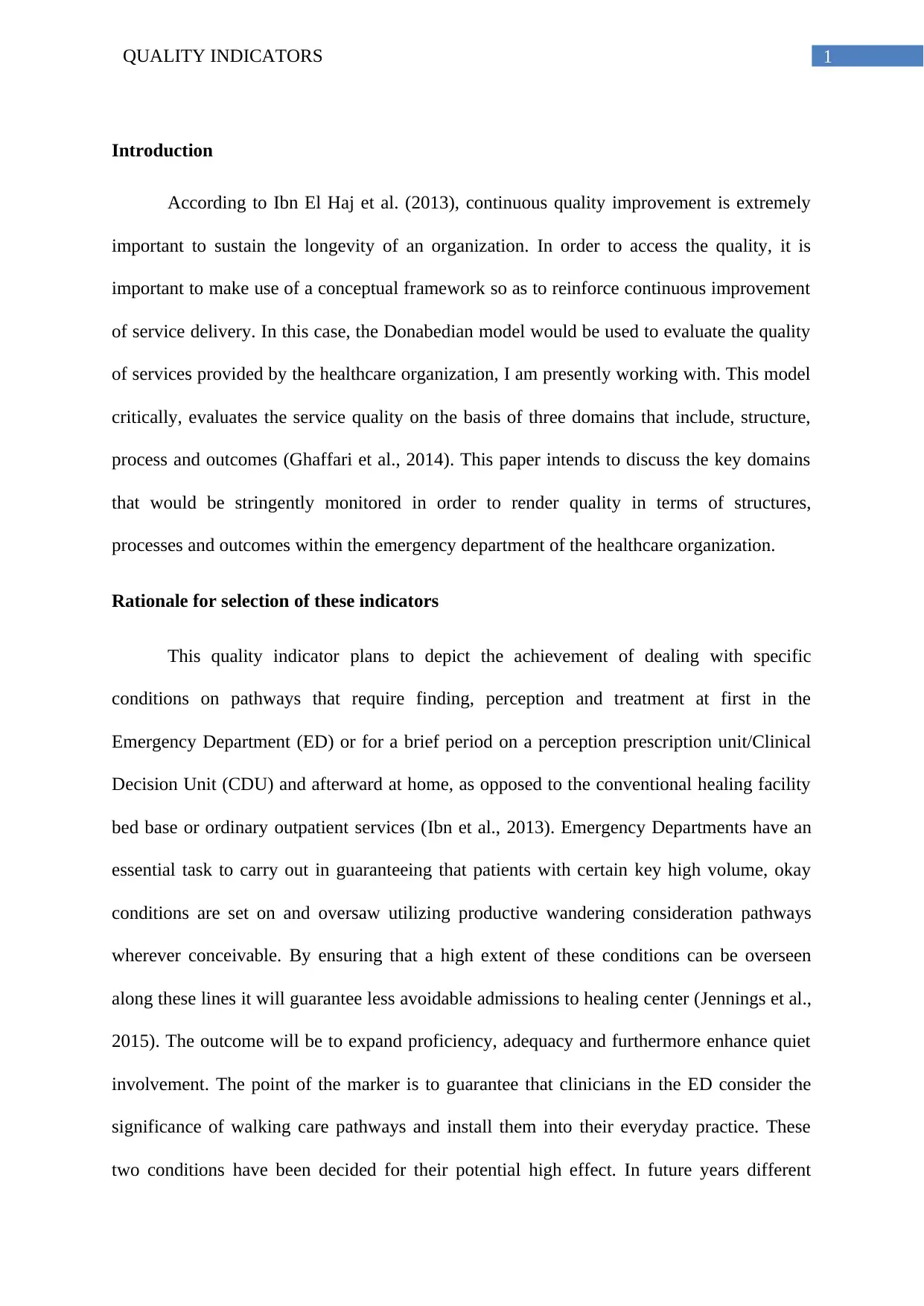
1QUALITY INDICATORS
Introduction
According to Ibn El Haj et al. (2013), continuous quality improvement is extremely
important to sustain the longevity of an organization. In order to access the quality, it is
important to make use of a conceptual framework so as to reinforce continuous improvement
of service delivery. In this case, the Donabedian model would be used to evaluate the quality
of services provided by the healthcare organization, I am presently working with. This model
critically, evaluates the service quality on the basis of three domains that include, structure,
process and outcomes (Ghaffari et al., 2014). This paper intends to discuss the key domains
that would be stringently monitored in order to render quality in terms of structures,
processes and outcomes within the emergency department of the healthcare organization.
Rationale for selection of these indicators
This quality indicator plans to depict the achievement of dealing with specific
conditions on pathways that require finding, perception and treatment at first in the
Emergency Department (ED) or for a brief period on a perception prescription unit/Clinical
Decision Unit (CDU) and afterward at home, as opposed to the conventional healing facility
bed base or ordinary outpatient services (Ibn et al., 2013). Emergency Departments have an
essential task to carry out in guaranteeing that patients with certain key high volume, okay
conditions are set on and oversaw utilizing productive wandering consideration pathways
wherever conceivable. By ensuring that a high extent of these conditions can be overseen
along these lines it will guarantee less avoidable admissions to healing center (Jennings et al.,
2015). The outcome will be to expand proficiency, adequacy and furthermore enhance quiet
involvement. The point of the marker is to guarantee that clinicians in the ED consider the
significance of walking care pathways and install them into their everyday practice. These
two conditions have been decided for their potential high effect. In future years different
Introduction
According to Ibn El Haj et al. (2013), continuous quality improvement is extremely
important to sustain the longevity of an organization. In order to access the quality, it is
important to make use of a conceptual framework so as to reinforce continuous improvement
of service delivery. In this case, the Donabedian model would be used to evaluate the quality
of services provided by the healthcare organization, I am presently working with. This model
critically, evaluates the service quality on the basis of three domains that include, structure,
process and outcomes (Ghaffari et al., 2014). This paper intends to discuss the key domains
that would be stringently monitored in order to render quality in terms of structures,
processes and outcomes within the emergency department of the healthcare organization.
Rationale for selection of these indicators
This quality indicator plans to depict the achievement of dealing with specific
conditions on pathways that require finding, perception and treatment at first in the
Emergency Department (ED) or for a brief period on a perception prescription unit/Clinical
Decision Unit (CDU) and afterward at home, as opposed to the conventional healing facility
bed base or ordinary outpatient services (Ibn et al., 2013). Emergency Departments have an
essential task to carry out in guaranteeing that patients with certain key high volume, okay
conditions are set on and oversaw utilizing productive wandering consideration pathways
wherever conceivable. By ensuring that a high extent of these conditions can be overseen
along these lines it will guarantee less avoidable admissions to healing center (Jennings et al.,
2015). The outcome will be to expand proficiency, adequacy and furthermore enhance quiet
involvement. The point of the marker is to guarantee that clinicians in the ED consider the
significance of walking care pathways and install them into their everyday practice. These
two conditions have been decided for their potential high effect. In future years different
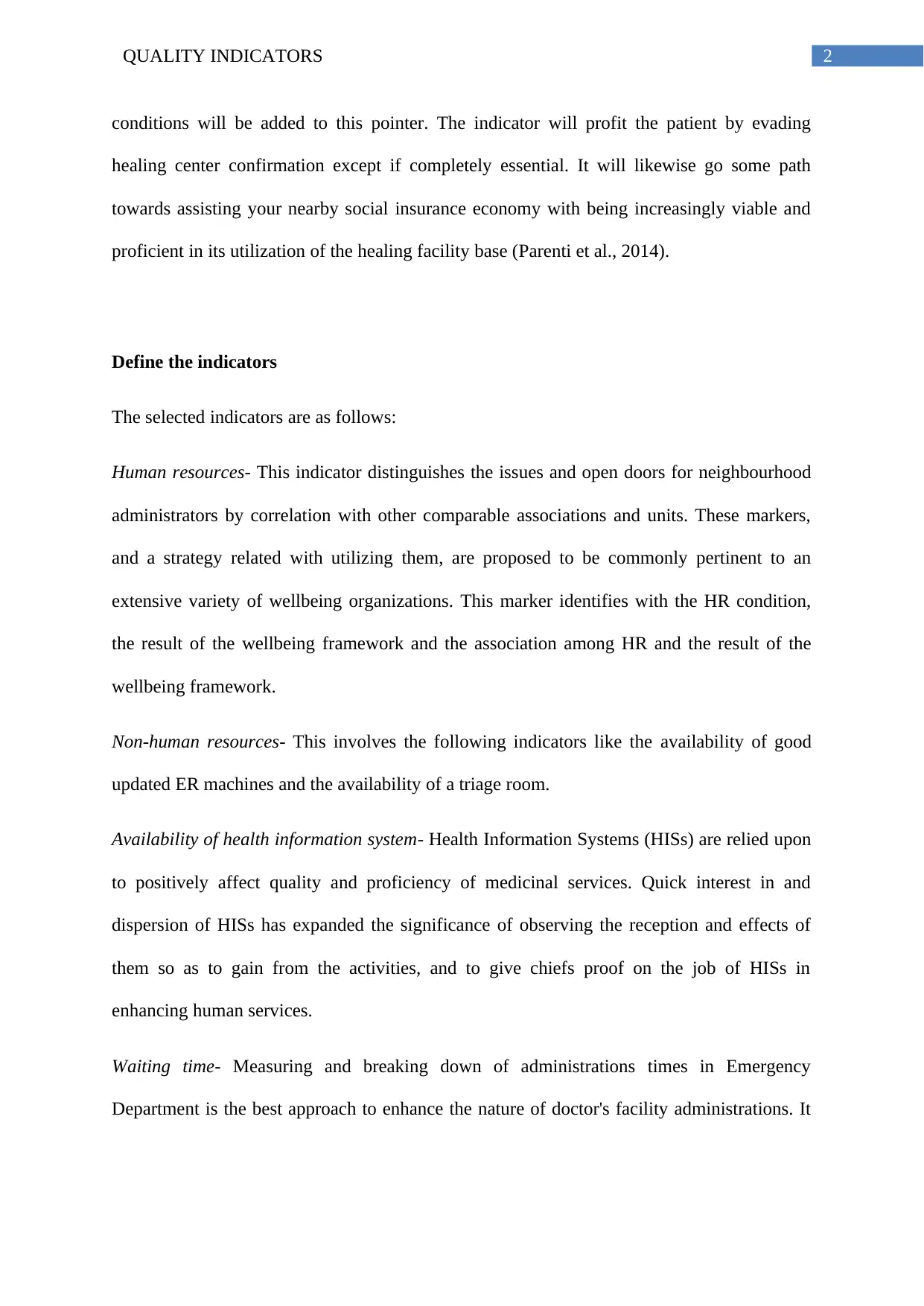
2QUALITY INDICATORS
conditions will be added to this pointer. The indicator will profit the patient by evading
healing center confirmation except if completely essential. It will likewise go some path
towards assisting your nearby social insurance economy with being increasingly viable and
proficient in its utilization of the healing facility base (Parenti et al., 2014).
Define the indicators
The selected indicators are as follows:
Human resources- This indicator distinguishes the issues and open doors for neighbourhood
administrators by correlation with other comparable associations and units. These markers,
and a strategy related with utilizing them, are proposed to be commonly pertinent to an
extensive variety of wellbeing organizations. This marker identifies with the HR condition,
the result of the wellbeing framework and the association among HR and the result of the
wellbeing framework.
Non-human resources- This involves the following indicators like the availability of good
updated ER machines and the availability of a triage room.
Availability of health information system- Health Information Systems (HISs) are relied upon
to positively affect quality and proficiency of medicinal services. Quick interest in and
dispersion of HISs has expanded the significance of observing the reception and effects of
them so as to gain from the activities, and to give chiefs proof on the job of HISs in
enhancing human services.
Waiting time- Measuring and breaking down of administrations times in Emergency
Department is the best approach to enhance the nature of doctor's facility administrations. It
conditions will be added to this pointer. The indicator will profit the patient by evading
healing center confirmation except if completely essential. It will likewise go some path
towards assisting your nearby social insurance economy with being increasingly viable and
proficient in its utilization of the healing facility base (Parenti et al., 2014).
Define the indicators
The selected indicators are as follows:
Human resources- This indicator distinguishes the issues and open doors for neighbourhood
administrators by correlation with other comparable associations and units. These markers,
and a strategy related with utilizing them, are proposed to be commonly pertinent to an
extensive variety of wellbeing organizations. This marker identifies with the HR condition,
the result of the wellbeing framework and the association among HR and the result of the
wellbeing framework.
Non-human resources- This involves the following indicators like the availability of good
updated ER machines and the availability of a triage room.
Availability of health information system- Health Information Systems (HISs) are relied upon
to positively affect quality and proficiency of medicinal services. Quick interest in and
dispersion of HISs has expanded the significance of observing the reception and effects of
them so as to gain from the activities, and to give chiefs proof on the job of HISs in
enhancing human services.
Waiting time- Measuring and breaking down of administrations times in Emergency
Department is the best approach to enhance the nature of doctor's facility administrations. It
⊘ This is a preview!⊘
Do you want full access?
Subscribe today to unlock all pages.

Trusted by 1+ million students worldwide
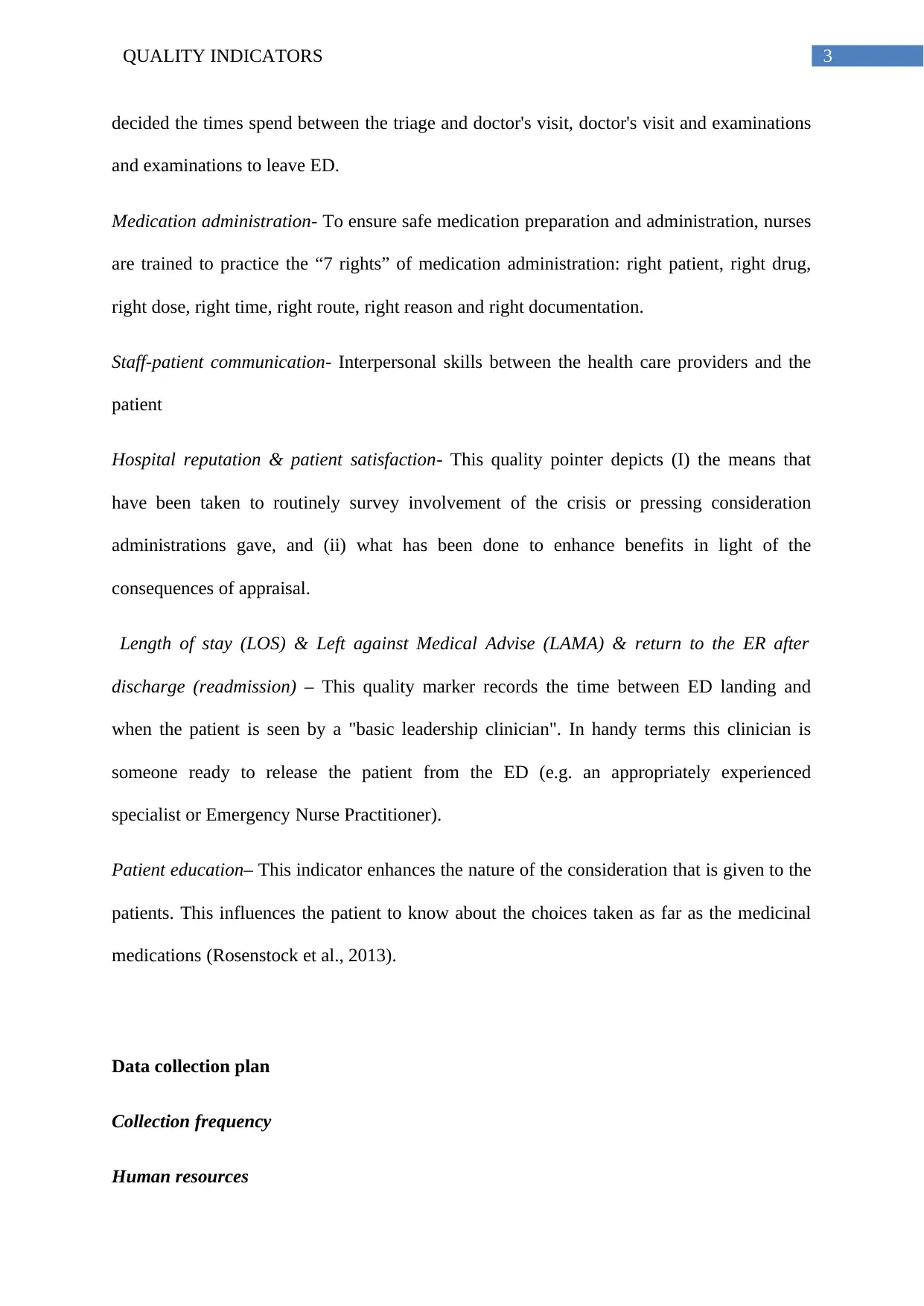
3QUALITY INDICATORS
decided the times spend between the triage and doctor's visit, doctor's visit and examinations
and examinations to leave ED.
Medication administration- To ensure safe medication preparation and administration, nurses
are trained to practice the “7 rights” of medication administration: right patient, right drug,
right dose, right time, right route, right reason and right documentation.
Staff-patient communication- Interpersonal skills between the health care providers and the
patient
Hospital reputation & patient satisfaction- This quality pointer depicts (I) the means that
have been taken to routinely survey involvement of the crisis or pressing consideration
administrations gave, and (ii) what has been done to enhance benefits in light of the
consequences of appraisal.
Length of stay (LOS) & Left against Medical Advise (LAMA) & return to the ER after
discharge (readmission) – This quality marker records the time between ED landing and
when the patient is seen by a "basic leadership clinician". In handy terms this clinician is
someone ready to release the patient from the ED (e.g. an appropriately experienced
specialist or Emergency Nurse Practitioner).
Patient education– This indicator enhances the nature of the consideration that is given to the
patients. This influences the patient to know about the choices taken as far as the medicinal
medications (Rosenstock et al., 2013).
Data collection plan
Collection frequency
Human resources
decided the times spend between the triage and doctor's visit, doctor's visit and examinations
and examinations to leave ED.
Medication administration- To ensure safe medication preparation and administration, nurses
are trained to practice the “7 rights” of medication administration: right patient, right drug,
right dose, right time, right route, right reason and right documentation.
Staff-patient communication- Interpersonal skills between the health care providers and the
patient
Hospital reputation & patient satisfaction- This quality pointer depicts (I) the means that
have been taken to routinely survey involvement of the crisis or pressing consideration
administrations gave, and (ii) what has been done to enhance benefits in light of the
consequences of appraisal.
Length of stay (LOS) & Left against Medical Advise (LAMA) & return to the ER after
discharge (readmission) – This quality marker records the time between ED landing and
when the patient is seen by a "basic leadership clinician". In handy terms this clinician is
someone ready to release the patient from the ED (e.g. an appropriately experienced
specialist or Emergency Nurse Practitioner).
Patient education– This indicator enhances the nature of the consideration that is given to the
patients. This influences the patient to know about the choices taken as far as the medicinal
medications (Rosenstock et al., 2013).
Data collection plan
Collection frequency
Human resources
Paraphrase This Document
Need a fresh take? Get an instant paraphrase of this document with our AI Paraphraser
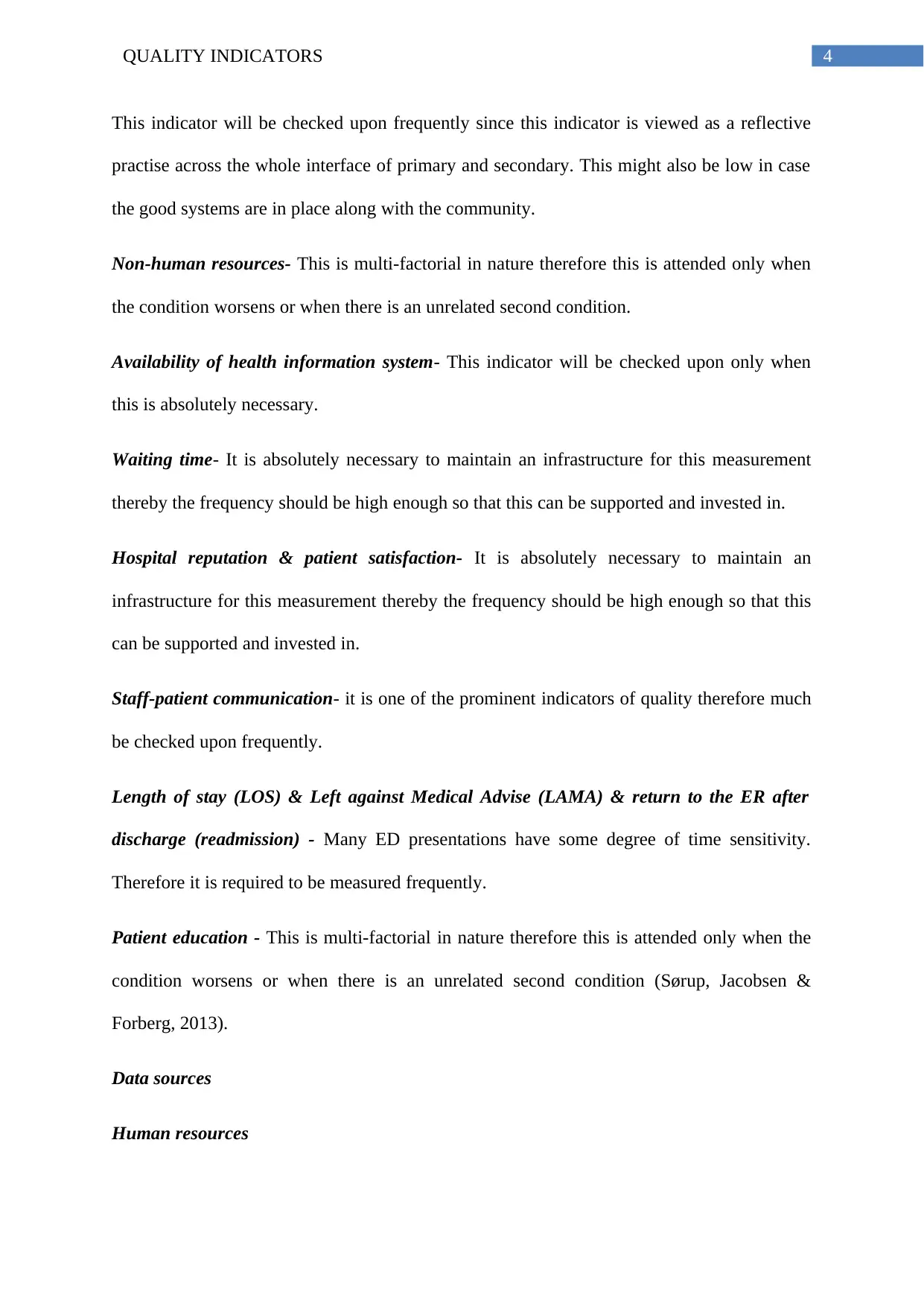
4QUALITY INDICATORS
This indicator will be checked upon frequently since this indicator is viewed as a reflective
practise across the whole interface of primary and secondary. This might also be low in case
the good systems are in place along with the community.
Non-human resources- This is multi-factorial in nature therefore this is attended only when
the condition worsens or when there is an unrelated second condition.
Availability of health information system- This indicator will be checked upon only when
this is absolutely necessary.
Waiting time- It is absolutely necessary to maintain an infrastructure for this measurement
thereby the frequency should be high enough so that this can be supported and invested in.
Hospital reputation & patient satisfaction- It is absolutely necessary to maintain an
infrastructure for this measurement thereby the frequency should be high enough so that this
can be supported and invested in.
Staff-patient communication- it is one of the prominent indicators of quality therefore much
be checked upon frequently.
Length of stay (LOS) & Left against Medical Advise (LAMA) & return to the ER after
discharge (readmission) - Many ED presentations have some degree of time sensitivity.
Therefore it is required to be measured frequently.
Patient education - This is multi-factorial in nature therefore this is attended only when the
condition worsens or when there is an unrelated second condition (Sørup, Jacobsen &
Forberg, 2013).
Data sources
Human resources
This indicator will be checked upon frequently since this indicator is viewed as a reflective
practise across the whole interface of primary and secondary. This might also be low in case
the good systems are in place along with the community.
Non-human resources- This is multi-factorial in nature therefore this is attended only when
the condition worsens or when there is an unrelated second condition.
Availability of health information system- This indicator will be checked upon only when
this is absolutely necessary.
Waiting time- It is absolutely necessary to maintain an infrastructure for this measurement
thereby the frequency should be high enough so that this can be supported and invested in.
Hospital reputation & patient satisfaction- It is absolutely necessary to maintain an
infrastructure for this measurement thereby the frequency should be high enough so that this
can be supported and invested in.
Staff-patient communication- it is one of the prominent indicators of quality therefore much
be checked upon frequently.
Length of stay (LOS) & Left against Medical Advise (LAMA) & return to the ER after
discharge (readmission) - Many ED presentations have some degree of time sensitivity.
Therefore it is required to be measured frequently.
Patient education - This is multi-factorial in nature therefore this is attended only when the
condition worsens or when there is an unrelated second condition (Sørup, Jacobsen &
Forberg, 2013).
Data sources
Human resources
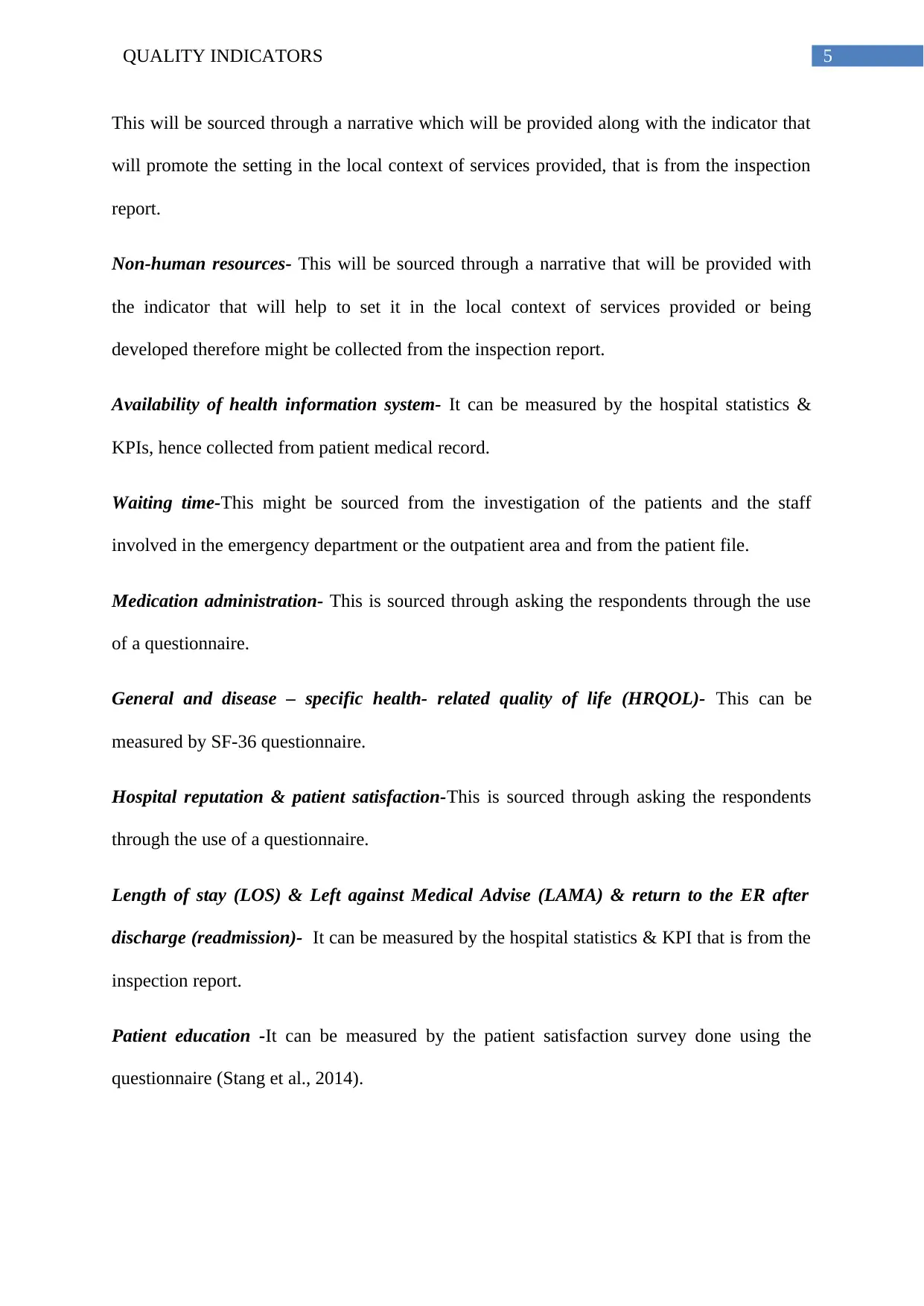
5QUALITY INDICATORS
This will be sourced through a narrative which will be provided along with the indicator that
will promote the setting in the local context of services provided, that is from the inspection
report.
Non-human resources- This will be sourced through a narrative that will be provided with
the indicator that will help to set it in the local context of services provided or being
developed therefore might be collected from the inspection report.
Availability of health information system- It can be measured by the hospital statistics &
KPIs, hence collected from patient medical record.
Waiting time-This might be sourced from the investigation of the patients and the staff
involved in the emergency department or the outpatient area and from the patient file.
Medication administration- This is sourced through asking the respondents through the use
of a questionnaire.
General and disease – specific health- related quality of life (HRQOL)- This can be
measured by SF-36 questionnaire.
Hospital reputation & patient satisfaction-This is sourced through asking the respondents
through the use of a questionnaire.
Length of stay (LOS) & Left against Medical Advise (LAMA) & return to the ER after
discharge (readmission)- It can be measured by the hospital statistics & KPI that is from the
inspection report.
Patient education -It can be measured by the patient satisfaction survey done using the
questionnaire (Stang et al., 2014).
This will be sourced through a narrative which will be provided along with the indicator that
will promote the setting in the local context of services provided, that is from the inspection
report.
Non-human resources- This will be sourced through a narrative that will be provided with
the indicator that will help to set it in the local context of services provided or being
developed therefore might be collected from the inspection report.
Availability of health information system- It can be measured by the hospital statistics &
KPIs, hence collected from patient medical record.
Waiting time-This might be sourced from the investigation of the patients and the staff
involved in the emergency department or the outpatient area and from the patient file.
Medication administration- This is sourced through asking the respondents through the use
of a questionnaire.
General and disease – specific health- related quality of life (HRQOL)- This can be
measured by SF-36 questionnaire.
Hospital reputation & patient satisfaction-This is sourced through asking the respondents
through the use of a questionnaire.
Length of stay (LOS) & Left against Medical Advise (LAMA) & return to the ER after
discharge (readmission)- It can be measured by the hospital statistics & KPI that is from the
inspection report.
Patient education -It can be measured by the patient satisfaction survey done using the
questionnaire (Stang et al., 2014).
⊘ This is a preview!⊘
Do you want full access?
Subscribe today to unlock all pages.

Trusted by 1+ million students worldwide
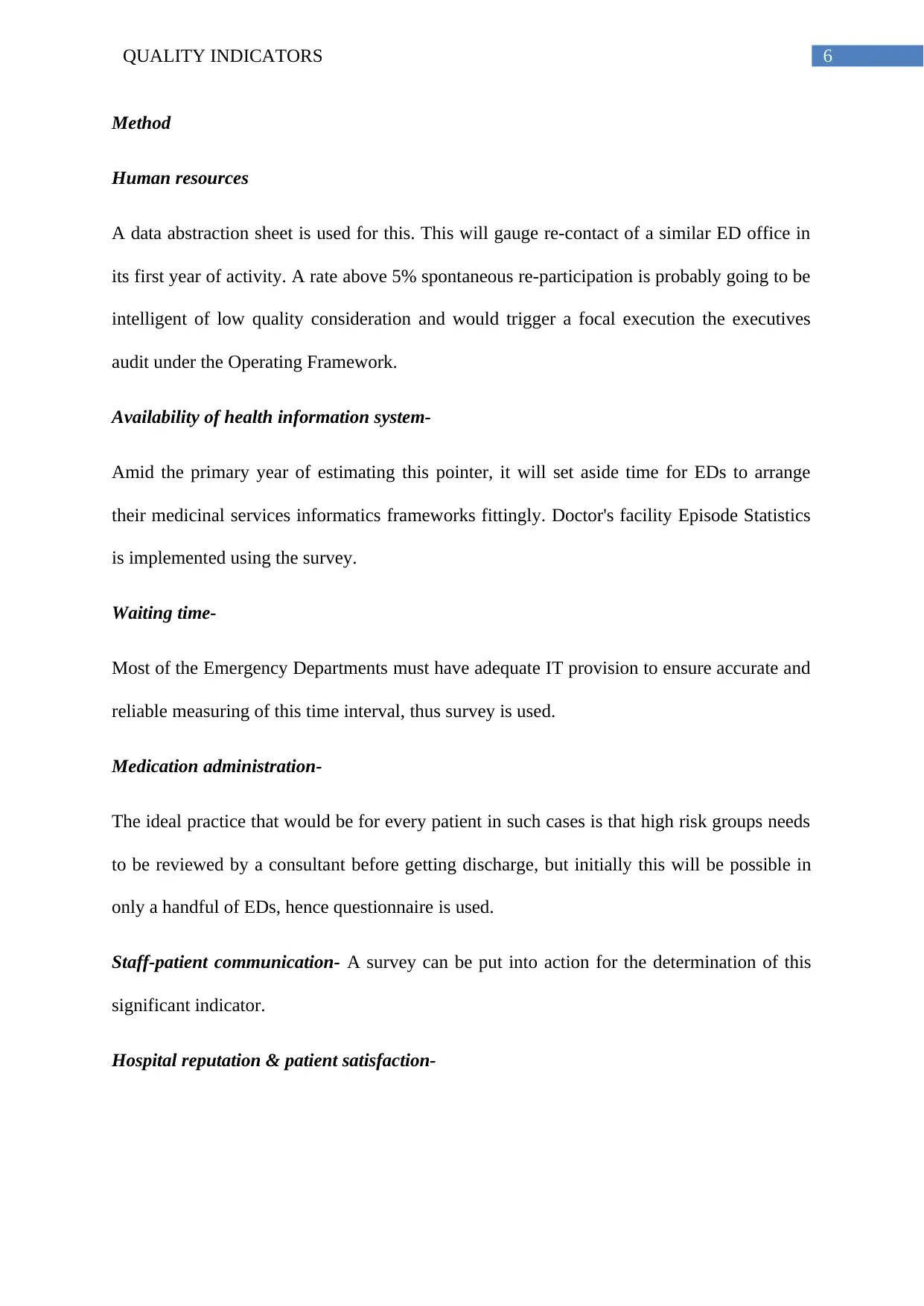
6QUALITY INDICATORS
Method
Human resources
A data abstraction sheet is used for this. This will gauge re-contact of a similar ED office in
its first year of activity. A rate above 5% spontaneous re-participation is probably going to be
intelligent of low quality consideration and would trigger a focal execution the executives
audit under the Operating Framework.
Availability of health information system-
Amid the primary year of estimating this pointer, it will set aside time for EDs to arrange
their medicinal services informatics frameworks fittingly. Doctor's facility Episode Statistics
is implemented using the survey.
Waiting time-
Most of the Emergency Departments must have adequate IT provision to ensure accurate and
reliable measuring of this time interval, thus survey is used.
Medication administration-
The ideal practice that would be for every patient in such cases is that high risk groups needs
to be reviewed by a consultant before getting discharge, but initially this will be possible in
only a handful of EDs, hence questionnaire is used.
Staff-patient communication- A survey can be put into action for the determination of this
significant indicator.
Hospital reputation & patient satisfaction-
Method
Human resources
A data abstraction sheet is used for this. This will gauge re-contact of a similar ED office in
its first year of activity. A rate above 5% spontaneous re-participation is probably going to be
intelligent of low quality consideration and would trigger a focal execution the executives
audit under the Operating Framework.
Availability of health information system-
Amid the primary year of estimating this pointer, it will set aside time for EDs to arrange
their medicinal services informatics frameworks fittingly. Doctor's facility Episode Statistics
is implemented using the survey.
Waiting time-
Most of the Emergency Departments must have adequate IT provision to ensure accurate and
reliable measuring of this time interval, thus survey is used.
Medication administration-
The ideal practice that would be for every patient in such cases is that high risk groups needs
to be reviewed by a consultant before getting discharge, but initially this will be possible in
only a handful of EDs, hence questionnaire is used.
Staff-patient communication- A survey can be put into action for the determination of this
significant indicator.
Hospital reputation & patient satisfaction-
Paraphrase This Document
Need a fresh take? Get an instant paraphrase of this document with our AI Paraphraser
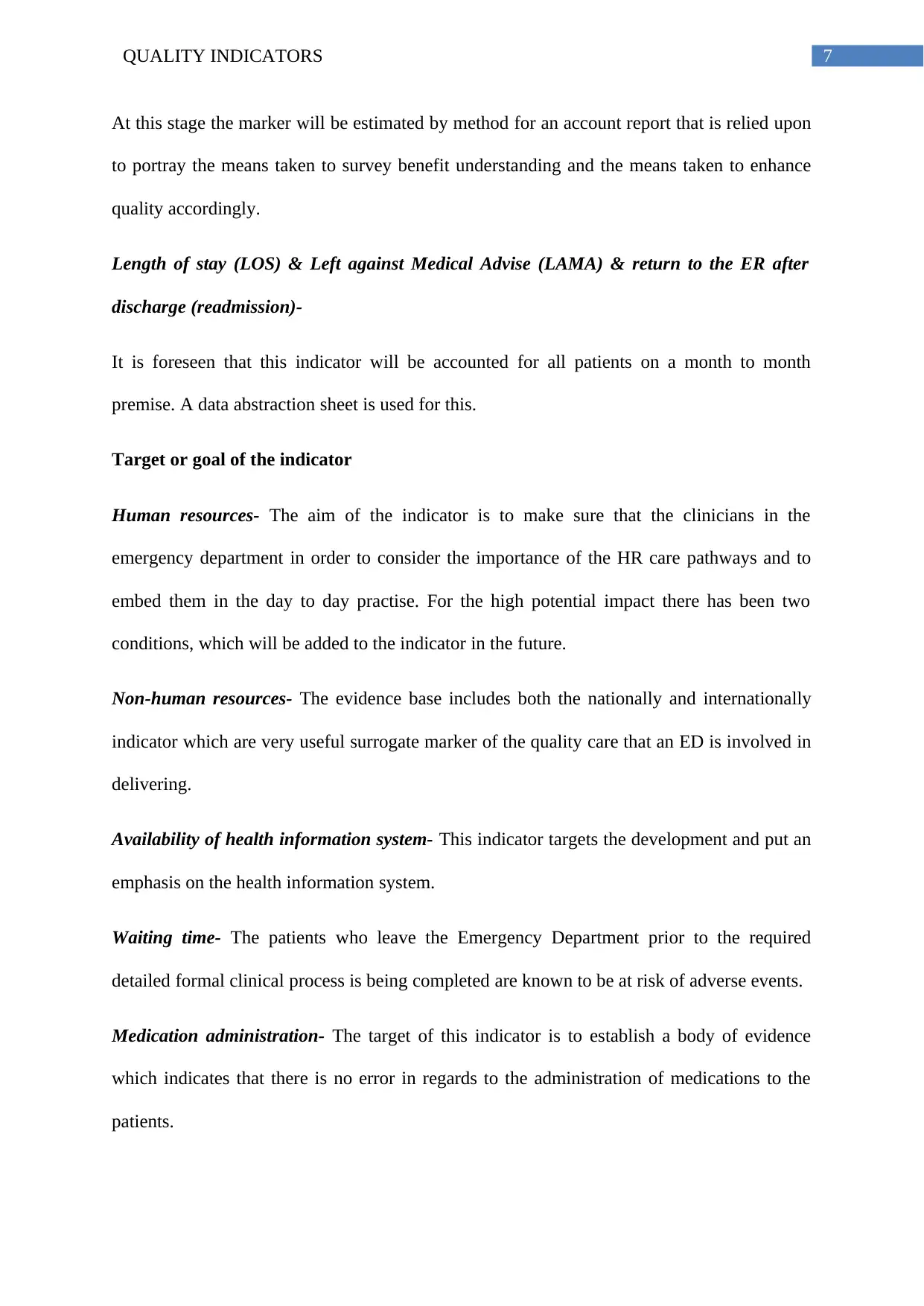
7QUALITY INDICATORS
At this stage the marker will be estimated by method for an account report that is relied upon
to portray the means taken to survey benefit understanding and the means taken to enhance
quality accordingly.
Length of stay (LOS) & Left against Medical Advise (LAMA) & return to the ER after
discharge (readmission)-
It is foreseen that this indicator will be accounted for all patients on a month to month
premise. A data abstraction sheet is used for this.
Target or goal of the indicator
Human resources- The aim of the indicator is to make sure that the clinicians in the
emergency department in order to consider the importance of the HR care pathways and to
embed them in the day to day practise. For the high potential impact there has been two
conditions, which will be added to the indicator in the future.
Non-human resources- The evidence base includes both the nationally and internationally
indicator which are very useful surrogate marker of the quality care that an ED is involved in
delivering.
Availability of health information system- This indicator targets the development and put an
emphasis on the health information system.
Waiting time- The patients who leave the Emergency Department prior to the required
detailed formal clinical process is being completed are known to be at risk of adverse events.
Medication administration- The target of this indicator is to establish a body of evidence
which indicates that there is no error in regards to the administration of medications to the
patients.
At this stage the marker will be estimated by method for an account report that is relied upon
to portray the means taken to survey benefit understanding and the means taken to enhance
quality accordingly.
Length of stay (LOS) & Left against Medical Advise (LAMA) & return to the ER after
discharge (readmission)-
It is foreseen that this indicator will be accounted for all patients on a month to month
premise. A data abstraction sheet is used for this.
Target or goal of the indicator
Human resources- The aim of the indicator is to make sure that the clinicians in the
emergency department in order to consider the importance of the HR care pathways and to
embed them in the day to day practise. For the high potential impact there has been two
conditions, which will be added to the indicator in the future.
Non-human resources- The evidence base includes both the nationally and internationally
indicator which are very useful surrogate marker of the quality care that an ED is involved in
delivering.
Availability of health information system- This indicator targets the development and put an
emphasis on the health information system.
Waiting time- The patients who leave the Emergency Department prior to the required
detailed formal clinical process is being completed are known to be at risk of adverse events.
Medication administration- The target of this indicator is to establish a body of evidence
which indicates that there is no error in regards to the administration of medications to the
patients.
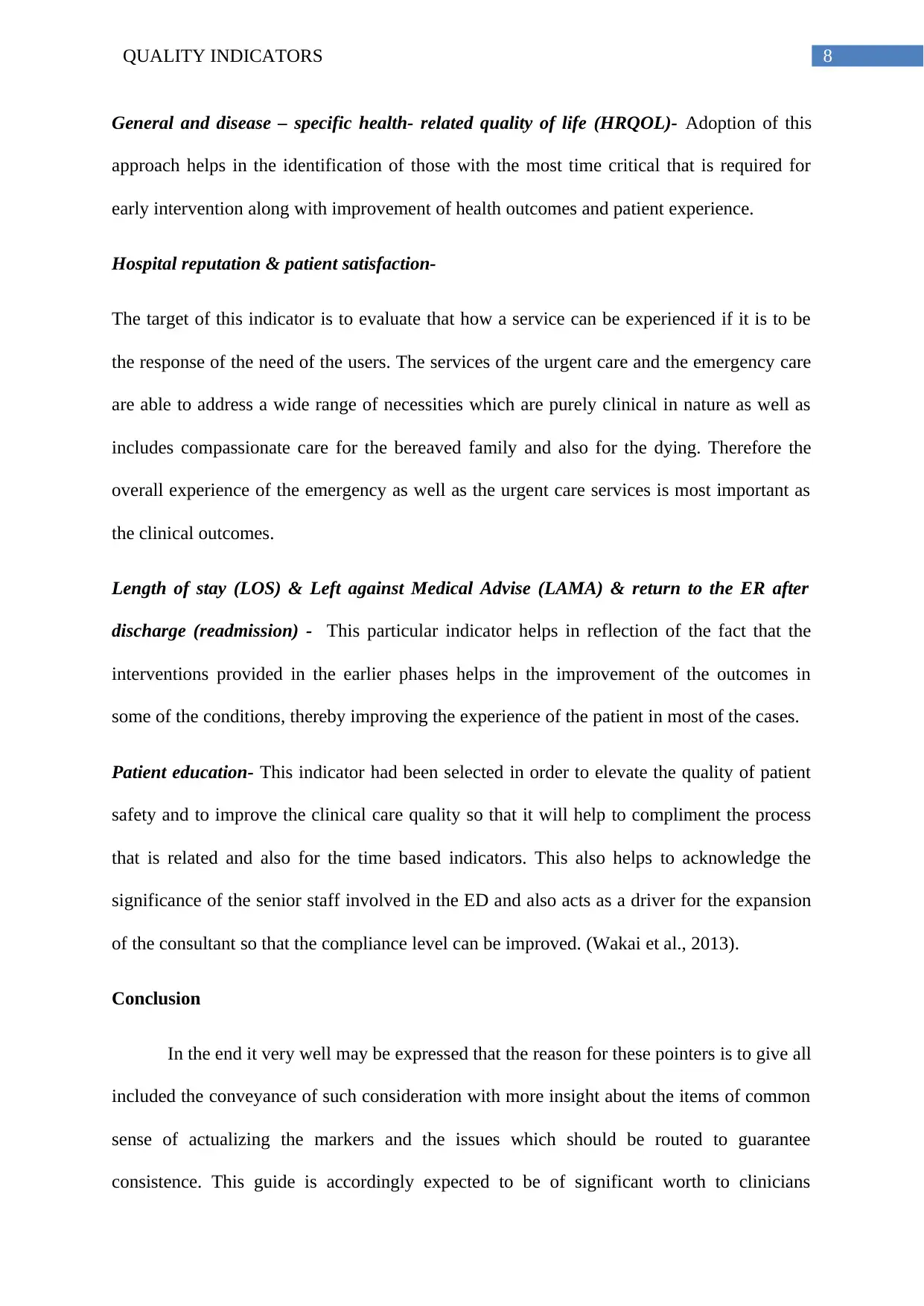
8QUALITY INDICATORS
General and disease – specific health- related quality of life (HRQOL)- Adoption of this
approach helps in the identification of those with the most time critical that is required for
early intervention along with improvement of health outcomes and patient experience.
Hospital reputation & patient satisfaction-
The target of this indicator is to evaluate that how a service can be experienced if it is to be
the response of the need of the users. The services of the urgent care and the emergency care
are able to address a wide range of necessities which are purely clinical in nature as well as
includes compassionate care for the bereaved family and also for the dying. Therefore the
overall experience of the emergency as well as the urgent care services is most important as
the clinical outcomes.
Length of stay (LOS) & Left against Medical Advise (LAMA) & return to the ER after
discharge (readmission) - This particular indicator helps in reflection of the fact that the
interventions provided in the earlier phases helps in the improvement of the outcomes in
some of the conditions, thereby improving the experience of the patient in most of the cases.
Patient education- This indicator had been selected in order to elevate the quality of patient
safety and to improve the clinical care quality so that it will help to compliment the process
that is related and also for the time based indicators. This also helps to acknowledge the
significance of the senior staff involved in the ED and also acts as a driver for the expansion
of the consultant so that the compliance level can be improved. (Wakai et al., 2013).
Conclusion
In the end it very well may be expressed that the reason for these pointers is to give all
included the conveyance of such consideration with more insight about the items of common
sense of actualizing the markers and the issues which should be routed to guarantee
consistence. This guide is accordingly expected to be of significant worth to clinicians
General and disease – specific health- related quality of life (HRQOL)- Adoption of this
approach helps in the identification of those with the most time critical that is required for
early intervention along with improvement of health outcomes and patient experience.
Hospital reputation & patient satisfaction-
The target of this indicator is to evaluate that how a service can be experienced if it is to be
the response of the need of the users. The services of the urgent care and the emergency care
are able to address a wide range of necessities which are purely clinical in nature as well as
includes compassionate care for the bereaved family and also for the dying. Therefore the
overall experience of the emergency as well as the urgent care services is most important as
the clinical outcomes.
Length of stay (LOS) & Left against Medical Advise (LAMA) & return to the ER after
discharge (readmission) - This particular indicator helps in reflection of the fact that the
interventions provided in the earlier phases helps in the improvement of the outcomes in
some of the conditions, thereby improving the experience of the patient in most of the cases.
Patient education- This indicator had been selected in order to elevate the quality of patient
safety and to improve the clinical care quality so that it will help to compliment the process
that is related and also for the time based indicators. This also helps to acknowledge the
significance of the senior staff involved in the ED and also acts as a driver for the expansion
of the consultant so that the compliance level can be improved. (Wakai et al., 2013).
Conclusion
In the end it very well may be expressed that the reason for these pointers is to give all
included the conveyance of such consideration with more insight about the items of common
sense of actualizing the markers and the issues which should be routed to guarantee
consistence. This guide is accordingly expected to be of significant worth to clinicians
⊘ This is a preview!⊘
Do you want full access?
Subscribe today to unlock all pages.

Trusted by 1+ million students worldwide
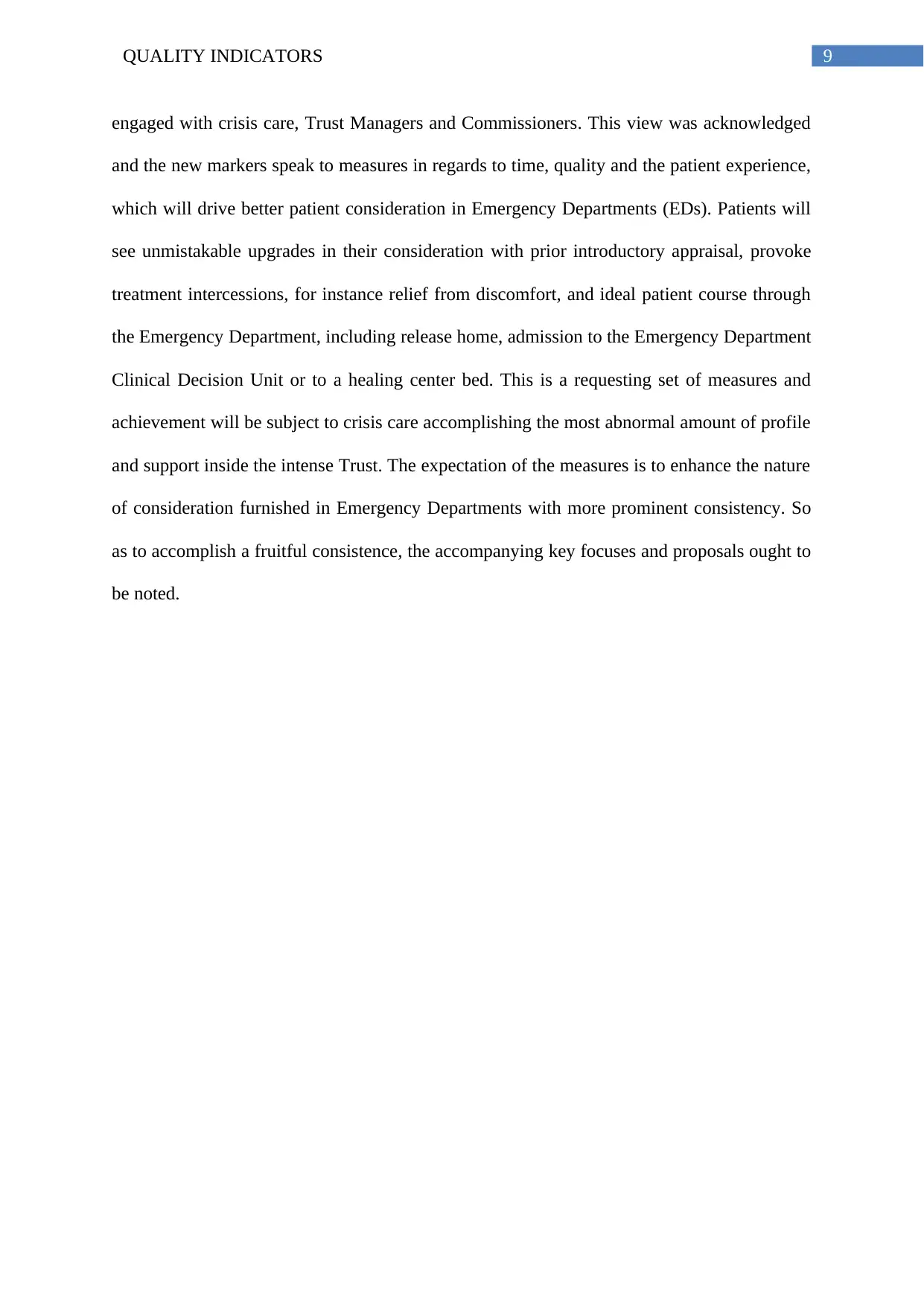
9QUALITY INDICATORS
engaged with crisis care, Trust Managers and Commissioners. This view was acknowledged
and the new markers speak to measures in regards to time, quality and the patient experience,
which will drive better patient consideration in Emergency Departments (EDs). Patients will
see unmistakable upgrades in their consideration with prior introductory appraisal, provoke
treatment intercessions, for instance relief from discomfort, and ideal patient course through
the Emergency Department, including release home, admission to the Emergency Department
Clinical Decision Unit or to a healing center bed. This is a requesting set of measures and
achievement will be subject to crisis care accomplishing the most abnormal amount of profile
and support inside the intense Trust. The expectation of the measures is to enhance the nature
of consideration furnished in Emergency Departments with more prominent consistency. So
as to accomplish a fruitful consistence, the accompanying key focuses and proposals ought to
be noted.
engaged with crisis care, Trust Managers and Commissioners. This view was acknowledged
and the new markers speak to measures in regards to time, quality and the patient experience,
which will drive better patient consideration in Emergency Departments (EDs). Patients will
see unmistakable upgrades in their consideration with prior introductory appraisal, provoke
treatment intercessions, for instance relief from discomfort, and ideal patient course through
the Emergency Department, including release home, admission to the Emergency Department
Clinical Decision Unit or to a healing center bed. This is a requesting set of measures and
achievement will be subject to crisis care accomplishing the most abnormal amount of profile
and support inside the intense Trust. The expectation of the measures is to enhance the nature
of consideration furnished in Emergency Departments with more prominent consistency. So
as to accomplish a fruitful consistence, the accompanying key focuses and proposals ought to
be noted.
Paraphrase This Document
Need a fresh take? Get an instant paraphrase of this document with our AI Paraphraser
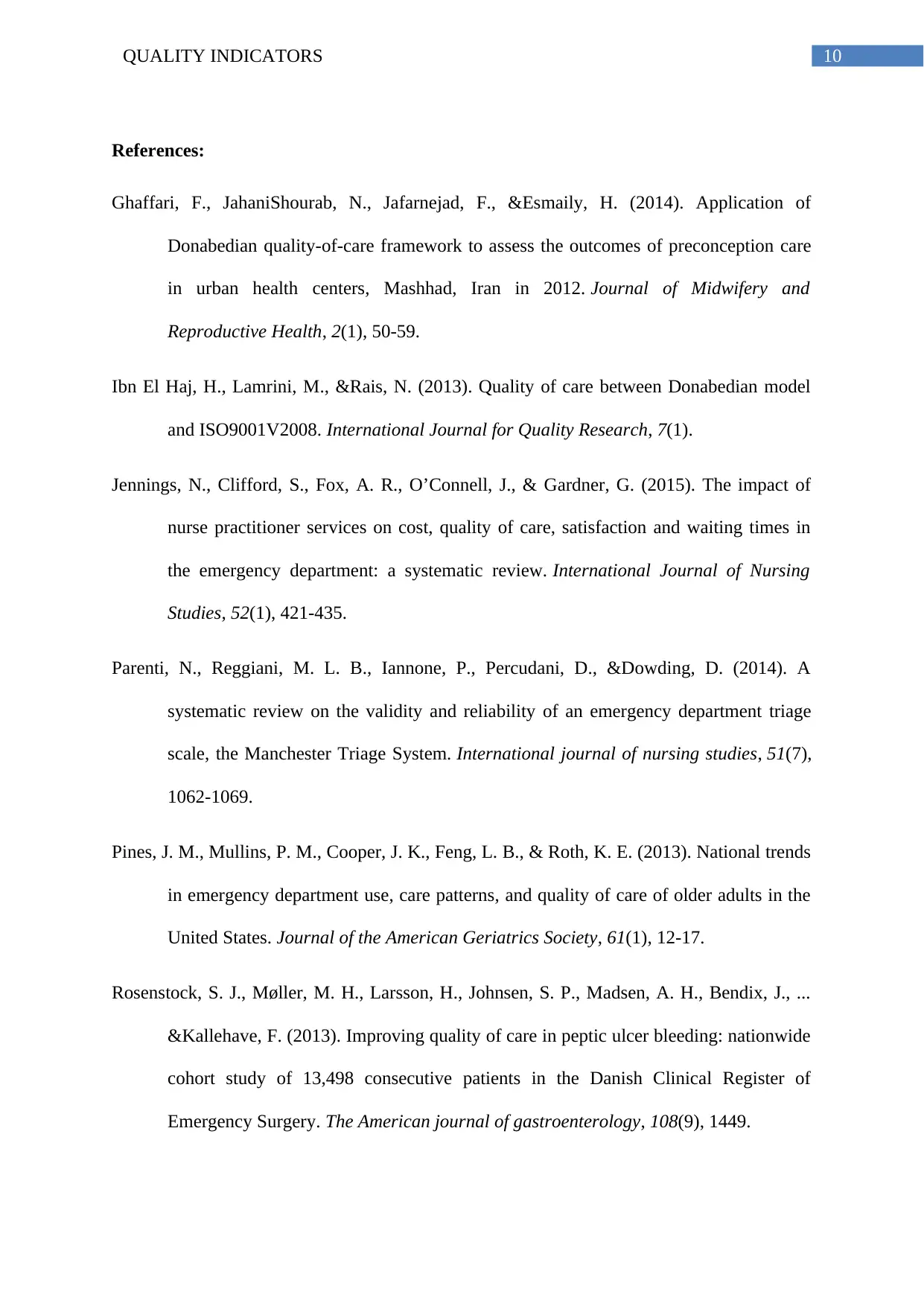
10QUALITY INDICATORS
References:
Ghaffari, F., JahaniShourab, N., Jafarnejad, F., &Esmaily, H. (2014). Application of
Donabedian quality-of-care framework to assess the outcomes of preconception care
in urban health centers, Mashhad, Iran in 2012. Journal of Midwifery and
Reproductive Health, 2(1), 50-59.
Ibn El Haj, H., Lamrini, M., &Rais, N. (2013). Quality of care between Donabedian model
and ISO9001V2008. International Journal for Quality Research, 7(1).
Jennings, N., Clifford, S., Fox, A. R., O’Connell, J., & Gardner, G. (2015). The impact of
nurse practitioner services on cost, quality of care, satisfaction and waiting times in
the emergency department: a systematic review. International Journal of Nursing
Studies, 52(1), 421-435.
Parenti, N., Reggiani, M. L. B., Iannone, P., Percudani, D., &Dowding, D. (2014). A
systematic review on the validity and reliability of an emergency department triage
scale, the Manchester Triage System. International journal of nursing studies, 51(7),
1062-1069.
Pines, J. M., Mullins, P. M., Cooper, J. K., Feng, L. B., & Roth, K. E. (2013). National trends
in emergency department use, care patterns, and quality of care of older adults in the
United States. Journal of the American Geriatrics Society, 61(1), 12-17.
Rosenstock, S. J., Møller, M. H., Larsson, H., Johnsen, S. P., Madsen, A. H., Bendix, J., ...
&Kallehave, F. (2013). Improving quality of care in peptic ulcer bleeding: nationwide
cohort study of 13,498 consecutive patients in the Danish Clinical Register of
Emergency Surgery. The American journal of gastroenterology, 108(9), 1449.
References:
Ghaffari, F., JahaniShourab, N., Jafarnejad, F., &Esmaily, H. (2014). Application of
Donabedian quality-of-care framework to assess the outcomes of preconception care
in urban health centers, Mashhad, Iran in 2012. Journal of Midwifery and
Reproductive Health, 2(1), 50-59.
Ibn El Haj, H., Lamrini, M., &Rais, N. (2013). Quality of care between Donabedian model
and ISO9001V2008. International Journal for Quality Research, 7(1).
Jennings, N., Clifford, S., Fox, A. R., O’Connell, J., & Gardner, G. (2015). The impact of
nurse practitioner services on cost, quality of care, satisfaction and waiting times in
the emergency department: a systematic review. International Journal of Nursing
Studies, 52(1), 421-435.
Parenti, N., Reggiani, M. L. B., Iannone, P., Percudani, D., &Dowding, D. (2014). A
systematic review on the validity and reliability of an emergency department triage
scale, the Manchester Triage System. International journal of nursing studies, 51(7),
1062-1069.
Pines, J. M., Mullins, P. M., Cooper, J. K., Feng, L. B., & Roth, K. E. (2013). National trends
in emergency department use, care patterns, and quality of care of older adults in the
United States. Journal of the American Geriatrics Society, 61(1), 12-17.
Rosenstock, S. J., Møller, M. H., Larsson, H., Johnsen, S. P., Madsen, A. H., Bendix, J., ...
&Kallehave, F. (2013). Improving quality of care in peptic ulcer bleeding: nationwide
cohort study of 13,498 consecutive patients in the Danish Clinical Register of
Emergency Surgery. The American journal of gastroenterology, 108(9), 1449.
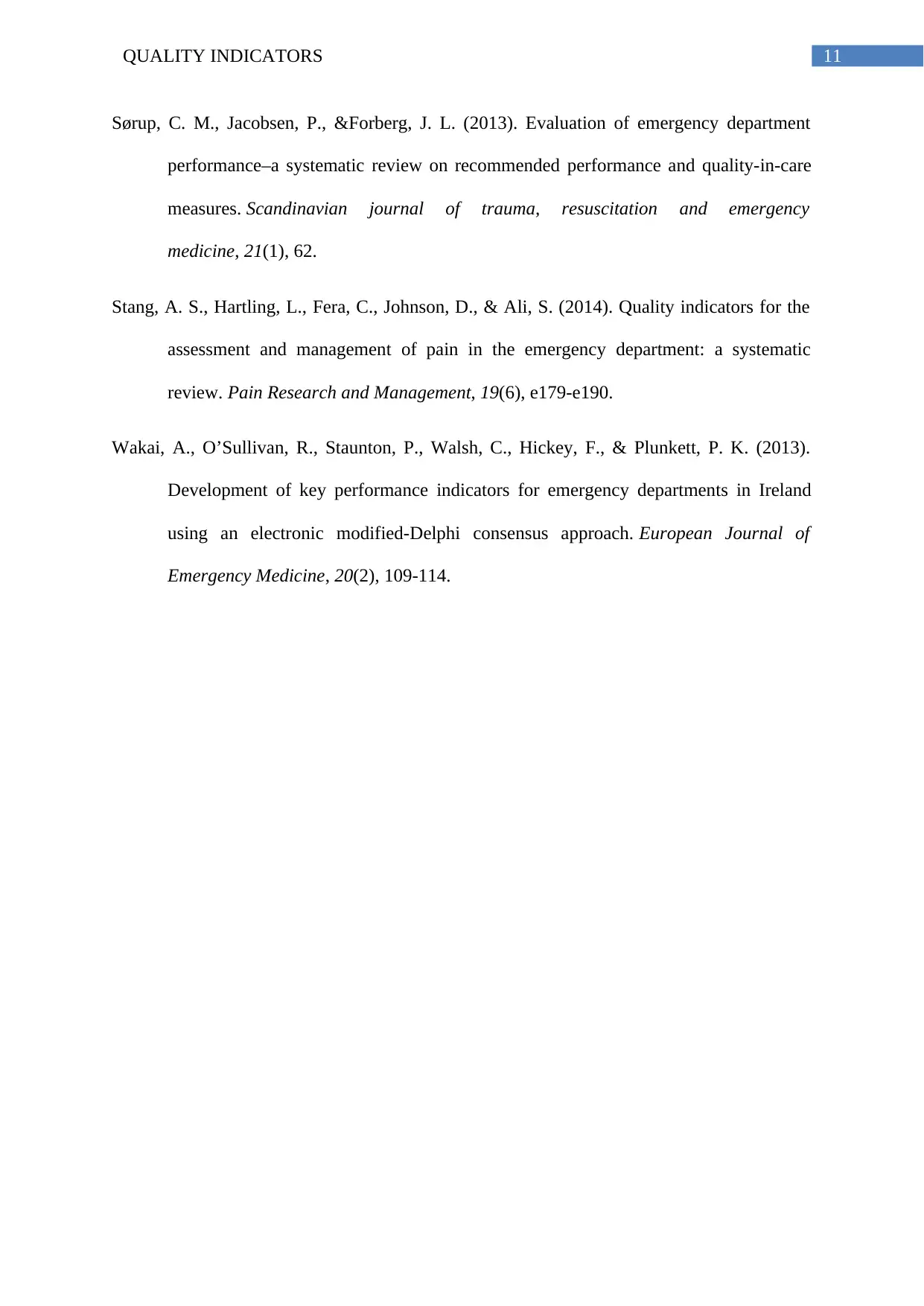
11QUALITY INDICATORS
Sørup, C. M., Jacobsen, P., &Forberg, J. L. (2013). Evaluation of emergency department
performance–a systematic review on recommended performance and quality-in-care
measures. Scandinavian journal of trauma, resuscitation and emergency
medicine, 21(1), 62.
Stang, A. S., Hartling, L., Fera, C., Johnson, D., & Ali, S. (2014). Quality indicators for the
assessment and management of pain in the emergency department: a systematic
review. Pain Research and Management, 19(6), e179-e190.
Wakai, A., O’Sullivan, R., Staunton, P., Walsh, C., Hickey, F., & Plunkett, P. K. (2013).
Development of key performance indicators for emergency departments in Ireland
using an electronic modified-Delphi consensus approach. European Journal of
Emergency Medicine, 20(2), 109-114.
Sørup, C. M., Jacobsen, P., &Forberg, J. L. (2013). Evaluation of emergency department
performance–a systematic review on recommended performance and quality-in-care
measures. Scandinavian journal of trauma, resuscitation and emergency
medicine, 21(1), 62.
Stang, A. S., Hartling, L., Fera, C., Johnson, D., & Ali, S. (2014). Quality indicators for the
assessment and management of pain in the emergency department: a systematic
review. Pain Research and Management, 19(6), e179-e190.
Wakai, A., O’Sullivan, R., Staunton, P., Walsh, C., Hickey, F., & Plunkett, P. K. (2013).
Development of key performance indicators for emergency departments in Ireland
using an electronic modified-Delphi consensus approach. European Journal of
Emergency Medicine, 20(2), 109-114.
⊘ This is a preview!⊘
Do you want full access?
Subscribe today to unlock all pages.

Trusted by 1+ million students worldwide
1 out of 12
Your All-in-One AI-Powered Toolkit for Academic Success.
+13062052269
info@desklib.com
Available 24*7 on WhatsApp / Email
![[object Object]](/_next/static/media/star-bottom.7253800d.svg)
Unlock your academic potential
Copyright © 2020–2025 A2Z Services. All Rights Reserved. Developed and managed by ZUCOL.